Legal Studies
VerifiedAdded on 2022/12/29
|12
|3603
|32
AI Summary
This document provides answers to legal case studies in the field of contract law and misrepresentation. It discusses the rights and remedies available to parties in different scenarios.
Contribute Materials
Your contribution can guide someone’s learning journey. Share your
documents today.
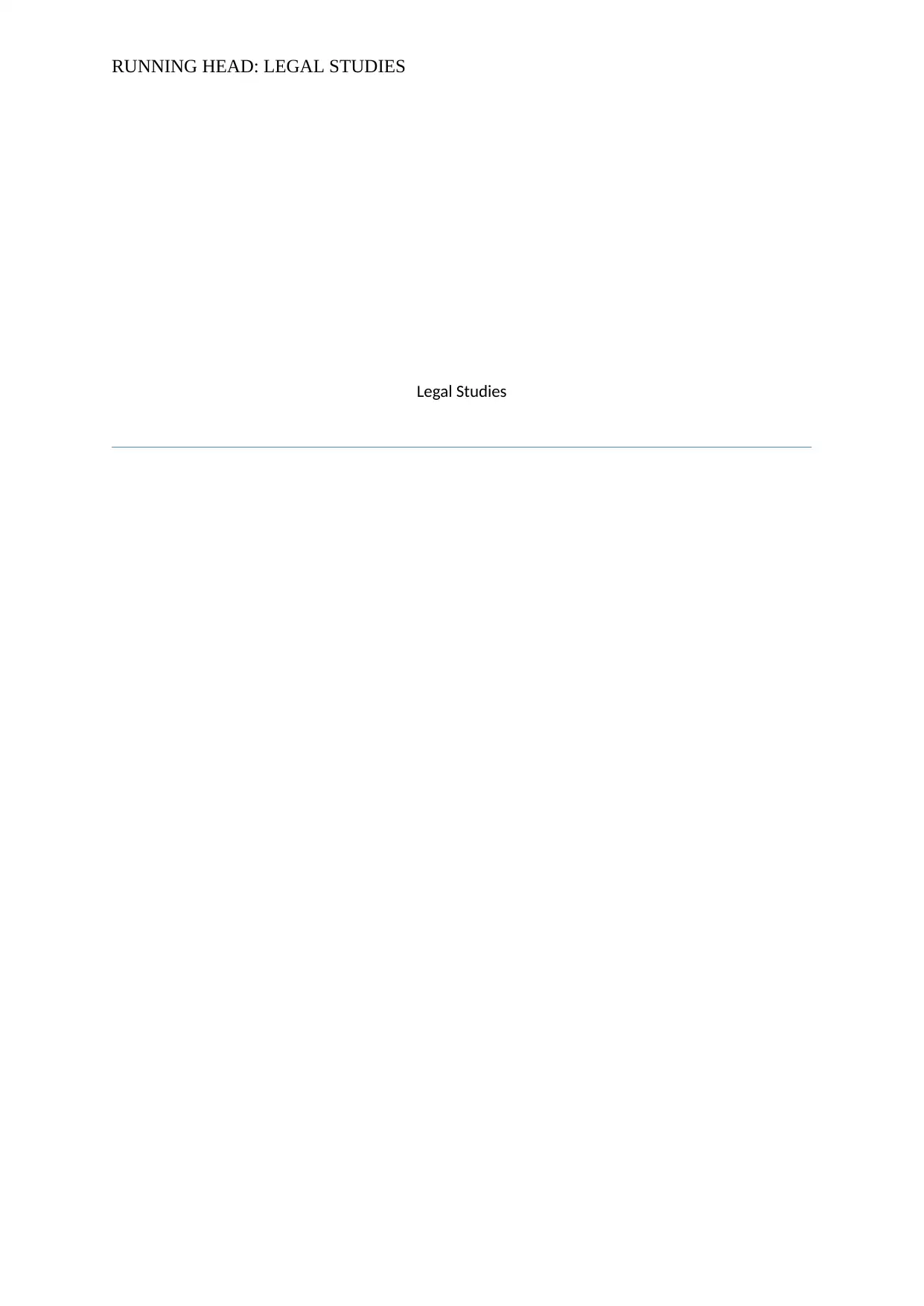
RUNNING HEAD: LEGAL STUDIES
Legal Studies
Legal Studies
Secure Best Marks with AI Grader
Need help grading? Try our AI Grader for instant feedback on your assignments.
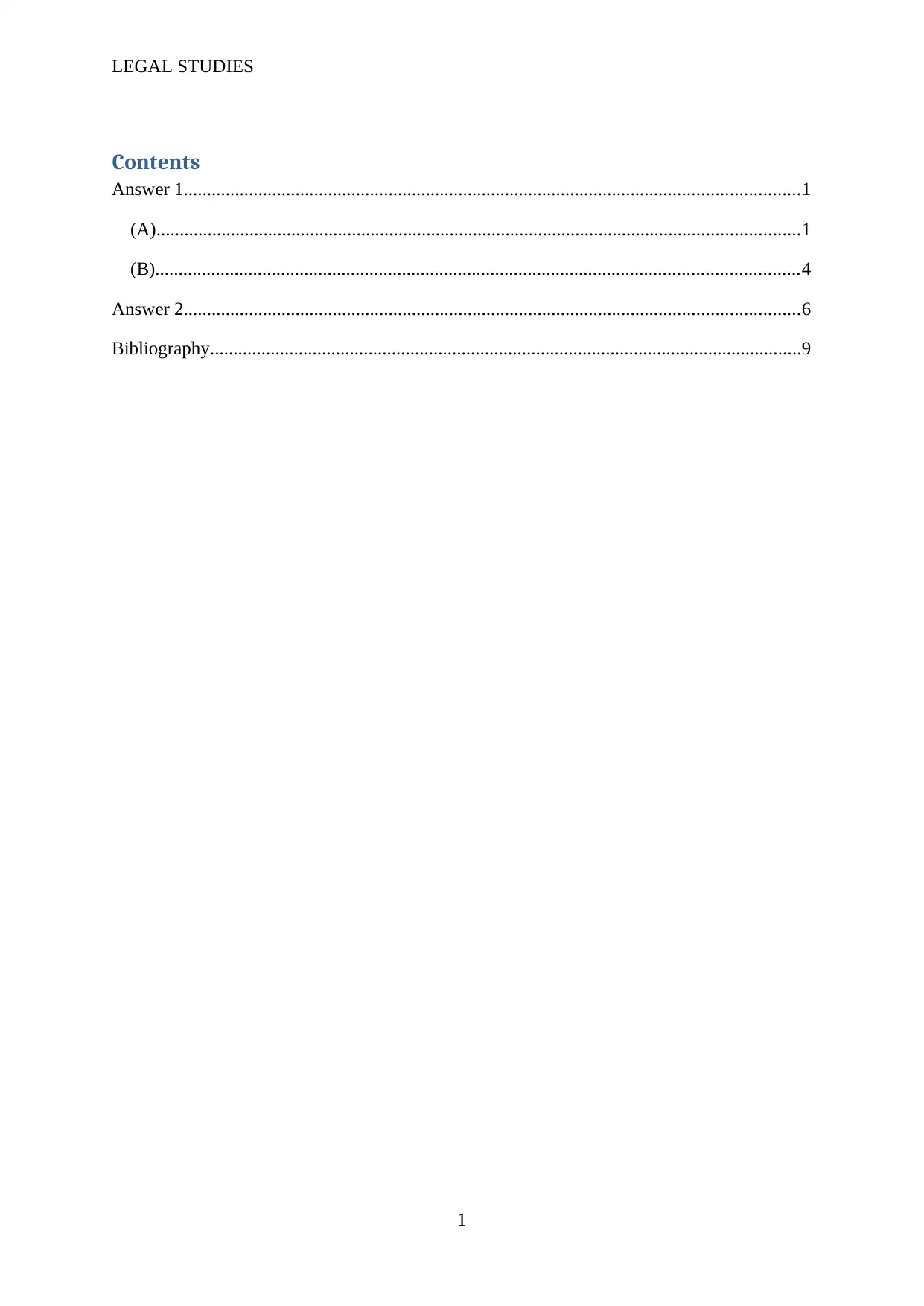
LEGAL STUDIES
Contents
Answer 1....................................................................................................................................1
(A)..........................................................................................................................................1
(B)..........................................................................................................................................4
Answer 2....................................................................................................................................6
Bibliography...............................................................................................................................9
1
Contents
Answer 1....................................................................................................................................1
(A)..........................................................................................................................................1
(B)..........................................................................................................................................4
Answer 2....................................................................................................................................6
Bibliography...............................................................................................................................9
1
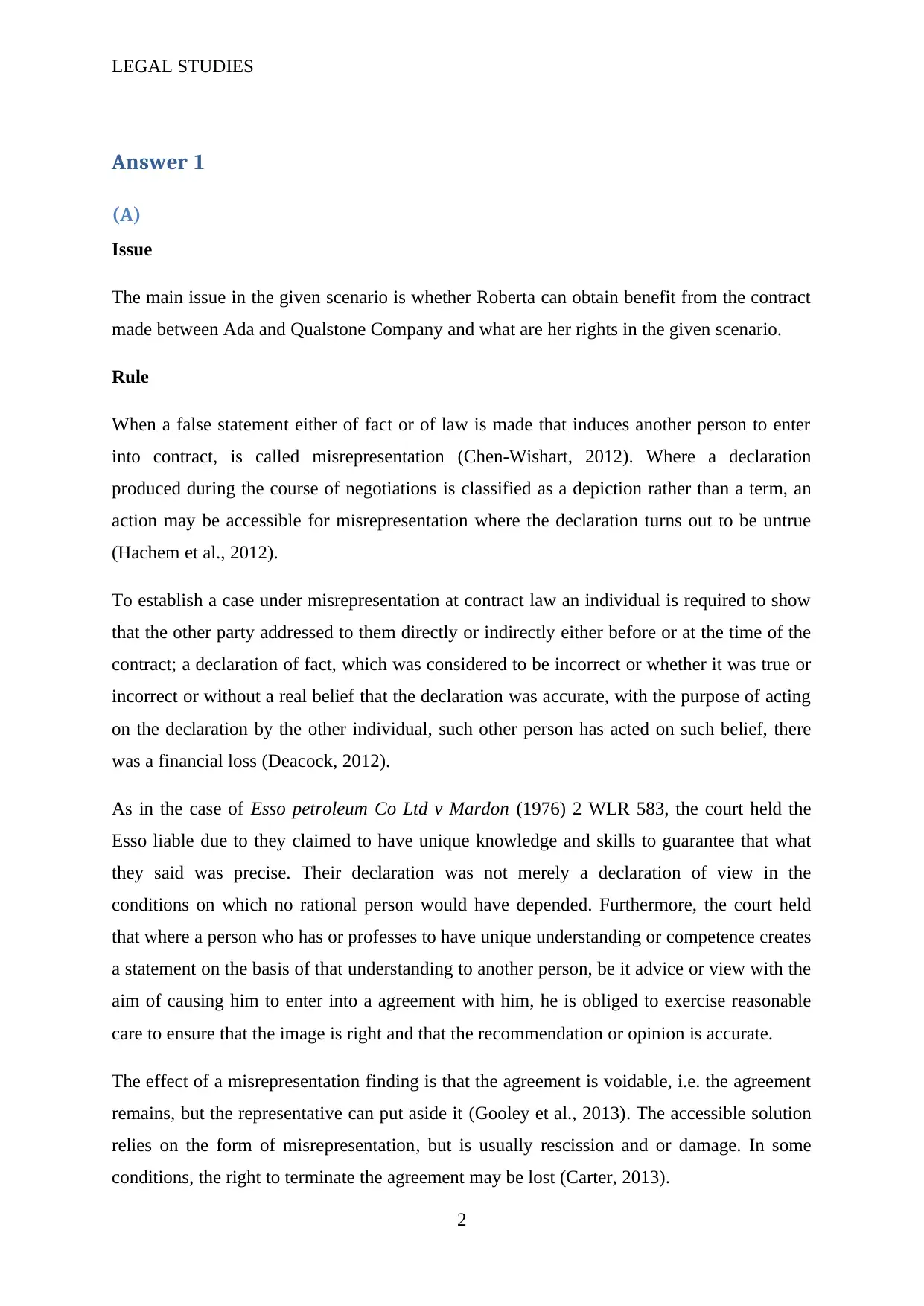
LEGAL STUDIES
Answer 1
(A)
Issue
The main issue in the given scenario is whether Roberta can obtain benefit from the contract
made between Ada and Qualstone Company and what are her rights in the given scenario.
Rule
When a false statement either of fact or of law is made that induces another person to enter
into contract, is called misrepresentation (Chen-Wishart, 2012). Where a declaration
produced during the course of negotiations is classified as a depiction rather than a term, an
action may be accessible for misrepresentation where the declaration turns out to be untrue
(Hachem et al., 2012).
To establish a case under misrepresentation at contract law an individual is required to show
that the other party addressed to them directly or indirectly either before or at the time of the
contract; a declaration of fact, which was considered to be incorrect or whether it was true or
incorrect or without a real belief that the declaration was accurate, with the purpose of acting
on the declaration by the other individual, such other person has acted on such belief, there
was a financial loss (Deacock, 2012).
As in the case of Esso petroleum Co Ltd v Mardon (1976) 2 WLR 583, the court held the
Esso liable due to they claimed to have unique knowledge and skills to guarantee that what
they said was precise. Their declaration was not merely a declaration of view in the
conditions on which no rational person would have depended. Furthermore, the court held
that where a person who has or professes to have unique understanding or competence creates
a statement on the basis of that understanding to another person, be it advice or view with the
aim of causing him to enter into a agreement with him, he is obliged to exercise reasonable
care to ensure that the image is right and that the recommendation or opinion is accurate.
The effect of a misrepresentation finding is that the agreement is voidable, i.e. the agreement
remains, but the representative can put aside it (Gooley et al., 2013). The accessible solution
relies on the form of misrepresentation, but is usually rescission and or damage. In some
conditions, the right to terminate the agreement may be lost (Carter, 2013).
2
Answer 1
(A)
Issue
The main issue in the given scenario is whether Roberta can obtain benefit from the contract
made between Ada and Qualstone Company and what are her rights in the given scenario.
Rule
When a false statement either of fact or of law is made that induces another person to enter
into contract, is called misrepresentation (Chen-Wishart, 2012). Where a declaration
produced during the course of negotiations is classified as a depiction rather than a term, an
action may be accessible for misrepresentation where the declaration turns out to be untrue
(Hachem et al., 2012).
To establish a case under misrepresentation at contract law an individual is required to show
that the other party addressed to them directly or indirectly either before or at the time of the
contract; a declaration of fact, which was considered to be incorrect or whether it was true or
incorrect or without a real belief that the declaration was accurate, with the purpose of acting
on the declaration by the other individual, such other person has acted on such belief, there
was a financial loss (Deacock, 2012).
As in the case of Esso petroleum Co Ltd v Mardon (1976) 2 WLR 583, the court held the
Esso liable due to they claimed to have unique knowledge and skills to guarantee that what
they said was precise. Their declaration was not merely a declaration of view in the
conditions on which no rational person would have depended. Furthermore, the court held
that where a person who has or professes to have unique understanding or competence creates
a statement on the basis of that understanding to another person, be it advice or view with the
aim of causing him to enter into a agreement with him, he is obliged to exercise reasonable
care to ensure that the image is right and that the recommendation or opinion is accurate.
The effect of a misrepresentation finding is that the agreement is voidable, i.e. the agreement
remains, but the representative can put aside it (Gooley et al., 2013). The accessible solution
relies on the form of misrepresentation, but is usually rescission and or damage. In some
conditions, the right to terminate the agreement may be lost (Carter, 2013).
2
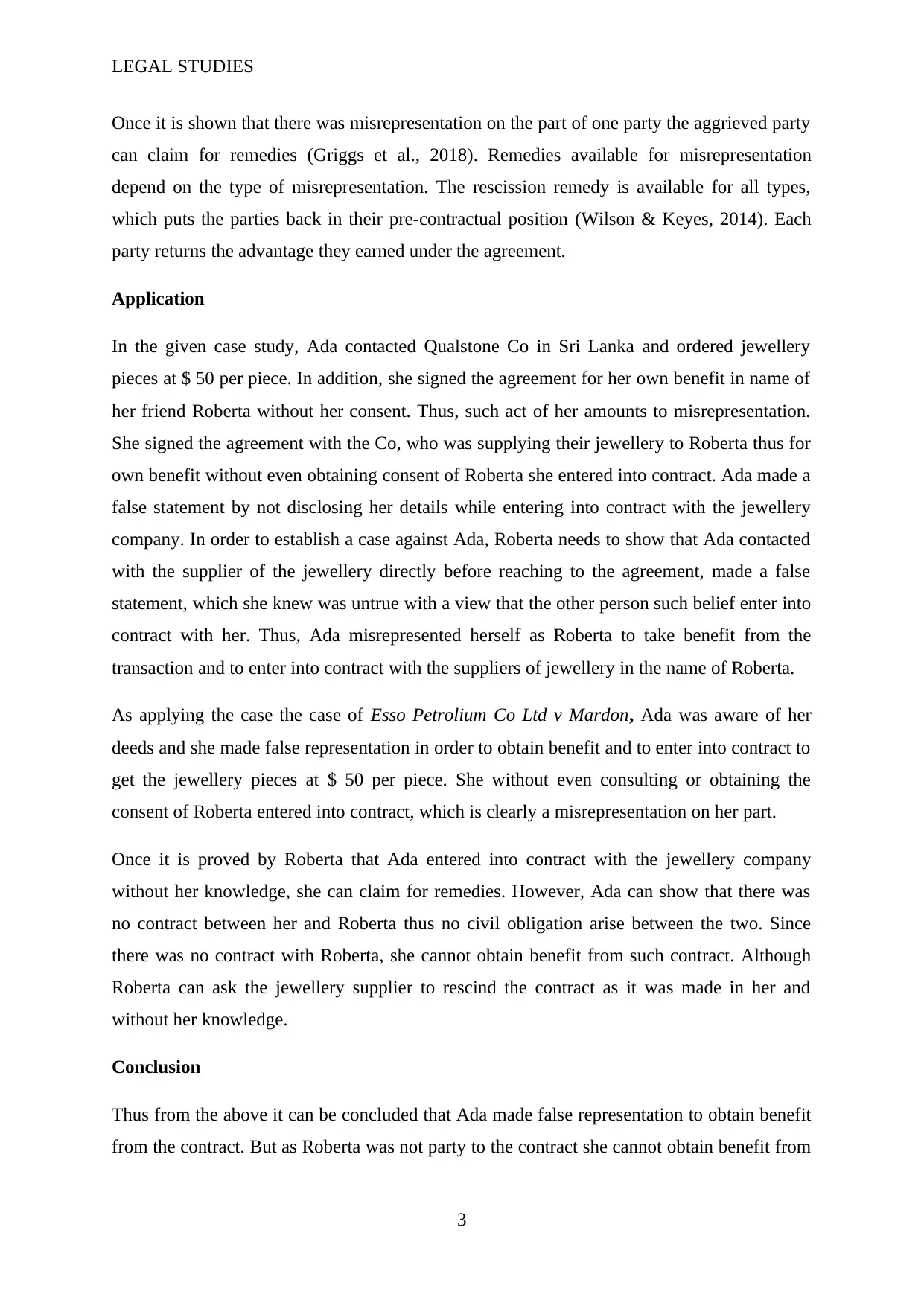
LEGAL STUDIES
Once it is shown that there was misrepresentation on the part of one party the aggrieved party
can claim for remedies (Griggs et al., 2018). Remedies available for misrepresentation
depend on the type of misrepresentation. The rescission remedy is available for all types,
which puts the parties back in their pre-contractual position (Wilson & Keyes, 2014). Each
party returns the advantage they earned under the agreement.
Application
In the given case study, Ada contacted Qualstone Co in Sri Lanka and ordered jewellery
pieces at $ 50 per piece. In addition, she signed the agreement for her own benefit in name of
her friend Roberta without her consent. Thus, such act of her amounts to misrepresentation.
She signed the agreement with the Co, who was supplying their jewellery to Roberta thus for
own benefit without even obtaining consent of Roberta she entered into contract. Ada made a
false statement by not disclosing her details while entering into contract with the jewellery
company. In order to establish a case against Ada, Roberta needs to show that Ada contacted
with the supplier of the jewellery directly before reaching to the agreement, made a false
statement, which she knew was untrue with a view that the other person such belief enter into
contract with her. Thus, Ada misrepresented herself as Roberta to take benefit from the
transaction and to enter into contract with the suppliers of jewellery in the name of Roberta.
As applying the case the case of Esso Petrolium Co Ltd v Mardon, Ada was aware of her
deeds and she made false representation in order to obtain benefit and to enter into contract to
get the jewellery pieces at $ 50 per piece. She without even consulting or obtaining the
consent of Roberta entered into contract, which is clearly a misrepresentation on her part.
Once it is proved by Roberta that Ada entered into contract with the jewellery company
without her knowledge, she can claim for remedies. However, Ada can show that there was
no contract between her and Roberta thus no civil obligation arise between the two. Since
there was no contract with Roberta, she cannot obtain benefit from such contract. Although
Roberta can ask the jewellery supplier to rescind the contract as it was made in her and
without her knowledge.
Conclusion
Thus from the above it can be concluded that Ada made false representation to obtain benefit
from the contract. But as Roberta was not party to the contract she cannot obtain benefit from
3
Once it is shown that there was misrepresentation on the part of one party the aggrieved party
can claim for remedies (Griggs et al., 2018). Remedies available for misrepresentation
depend on the type of misrepresentation. The rescission remedy is available for all types,
which puts the parties back in their pre-contractual position (Wilson & Keyes, 2014). Each
party returns the advantage they earned under the agreement.
Application
In the given case study, Ada contacted Qualstone Co in Sri Lanka and ordered jewellery
pieces at $ 50 per piece. In addition, she signed the agreement for her own benefit in name of
her friend Roberta without her consent. Thus, such act of her amounts to misrepresentation.
She signed the agreement with the Co, who was supplying their jewellery to Roberta thus for
own benefit without even obtaining consent of Roberta she entered into contract. Ada made a
false statement by not disclosing her details while entering into contract with the jewellery
company. In order to establish a case against Ada, Roberta needs to show that Ada contacted
with the supplier of the jewellery directly before reaching to the agreement, made a false
statement, which she knew was untrue with a view that the other person such belief enter into
contract with her. Thus, Ada misrepresented herself as Roberta to take benefit from the
transaction and to enter into contract with the suppliers of jewellery in the name of Roberta.
As applying the case the case of Esso Petrolium Co Ltd v Mardon, Ada was aware of her
deeds and she made false representation in order to obtain benefit and to enter into contract to
get the jewellery pieces at $ 50 per piece. She without even consulting or obtaining the
consent of Roberta entered into contract, which is clearly a misrepresentation on her part.
Once it is proved by Roberta that Ada entered into contract with the jewellery company
without her knowledge, she can claim for remedies. However, Ada can show that there was
no contract between her and Roberta thus no civil obligation arise between the two. Since
there was no contract with Roberta, she cannot obtain benefit from such contract. Although
Roberta can ask the jewellery supplier to rescind the contract as it was made in her and
without her knowledge.
Conclusion
Thus from the above it can be concluded that Ada made false representation to obtain benefit
from the contract. But as Roberta was not party to the contract she cannot obtain benefit from
3
Secure Best Marks with AI Grader
Need help grading? Try our AI Grader for instant feedback on your assignments.
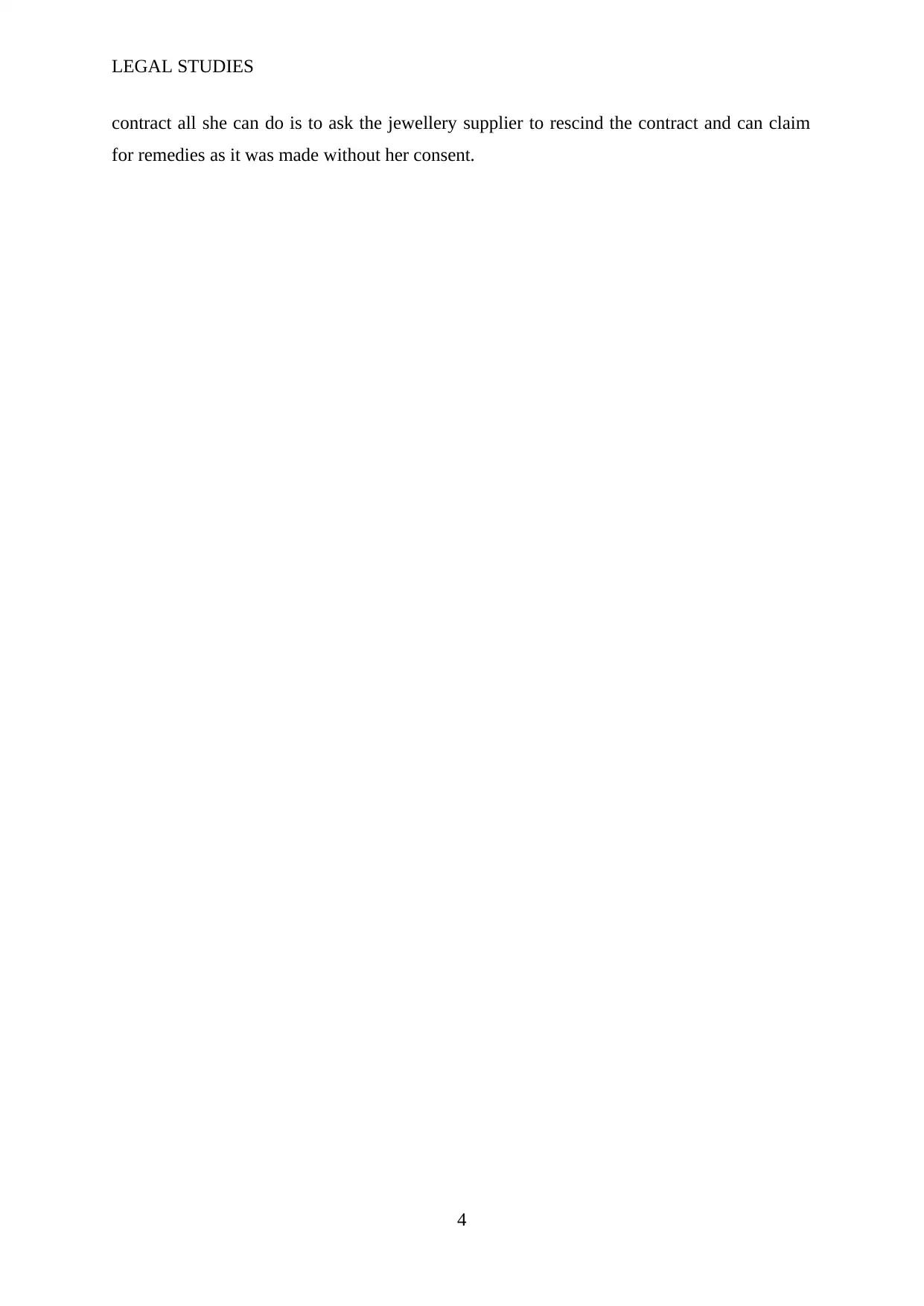
LEGAL STUDIES
contract all she can do is to ask the jewellery supplier to rescind the contract and can claim
for remedies as it was made without her consent.
4
contract all she can do is to ask the jewellery supplier to rescind the contract and can claim
for remedies as it was made without her consent.
4
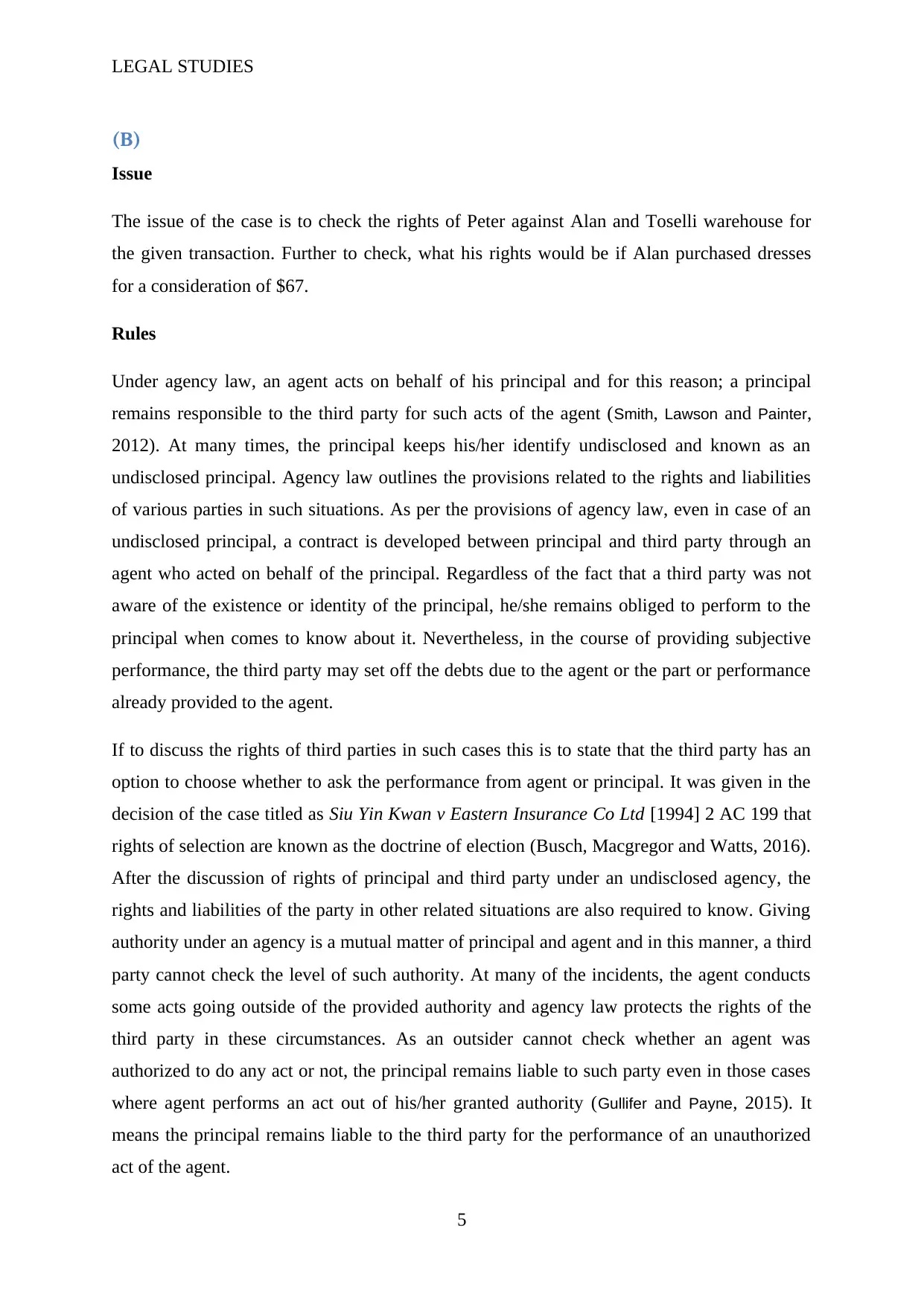
LEGAL STUDIES
(B)
Issue
The issue of the case is to check the rights of Peter against Alan and Toselli warehouse for
the given transaction. Further to check, what his rights would be if Alan purchased dresses
for a consideration of $67.
Rules
Under agency law, an agent acts on behalf of his principal and for this reason; a principal
remains responsible to the third party for such acts of the agent (Smith, Lawson and Painter,
2012). At many times, the principal keeps his/her identify undisclosed and known as an
undisclosed principal. Agency law outlines the provisions related to the rights and liabilities
of various parties in such situations. As per the provisions of agency law, even in case of an
undisclosed principal, a contract is developed between principal and third party through an
agent who acted on behalf of the principal. Regardless of the fact that a third party was not
aware of the existence or identity of the principal, he/she remains obliged to perform to the
principal when comes to know about it. Nevertheless, in the course of providing subjective
performance, the third party may set off the debts due to the agent or the part or performance
already provided to the agent.
If to discuss the rights of third parties in such cases this is to state that the third party has an
option to choose whether to ask the performance from agent or principal. It was given in the
decision of the case titled as Siu Yin Kwan v Eastern Insurance Co Ltd [1994] 2 AC 199 that
rights of selection are known as the doctrine of election (Busch, Macgregor and Watts, 2016).
After the discussion of rights of principal and third party under an undisclosed agency, the
rights and liabilities of the party in other related situations are also required to know. Giving
authority under an agency is a mutual matter of principal and agent and in this manner, a third
party cannot check the level of such authority. At many of the incidents, the agent conducts
some acts going outside of the provided authority and agency law protects the rights of the
third party in these circumstances. As an outsider cannot check whether an agent was
authorized to do any act or not, the principal remains liable to such party even in those cases
where agent performs an act out of his/her granted authority (Gullifer and Payne, 2015). It
means the principal remains liable to the third party for the performance of an unauthorized
act of the agent.
5
(B)
Issue
The issue of the case is to check the rights of Peter against Alan and Toselli warehouse for
the given transaction. Further to check, what his rights would be if Alan purchased dresses
for a consideration of $67.
Rules
Under agency law, an agent acts on behalf of his principal and for this reason; a principal
remains responsible to the third party for such acts of the agent (Smith, Lawson and Painter,
2012). At many times, the principal keeps his/her identify undisclosed and known as an
undisclosed principal. Agency law outlines the provisions related to the rights and liabilities
of various parties in such situations. As per the provisions of agency law, even in case of an
undisclosed principal, a contract is developed between principal and third party through an
agent who acted on behalf of the principal. Regardless of the fact that a third party was not
aware of the existence or identity of the principal, he/she remains obliged to perform to the
principal when comes to know about it. Nevertheless, in the course of providing subjective
performance, the third party may set off the debts due to the agent or the part or performance
already provided to the agent.
If to discuss the rights of third parties in such cases this is to state that the third party has an
option to choose whether to ask the performance from agent or principal. It was given in the
decision of the case titled as Siu Yin Kwan v Eastern Insurance Co Ltd [1994] 2 AC 199 that
rights of selection are known as the doctrine of election (Busch, Macgregor and Watts, 2016).
After the discussion of rights of principal and third party under an undisclosed agency, the
rights and liabilities of the party in other related situations are also required to know. Giving
authority under an agency is a mutual matter of principal and agent and in this manner, a third
party cannot check the level of such authority. At many of the incidents, the agent conducts
some acts going outside of the provided authority and agency law protects the rights of the
third party in these circumstances. As an outsider cannot check whether an agent was
authorized to do any act or not, the principal remains liable to such party even in those cases
where agent performs an act out of his/her granted authority (Gullifer and Payne, 2015). It
means the principal remains liable to the third party for the performance of an unauthorized
act of the agent.
5
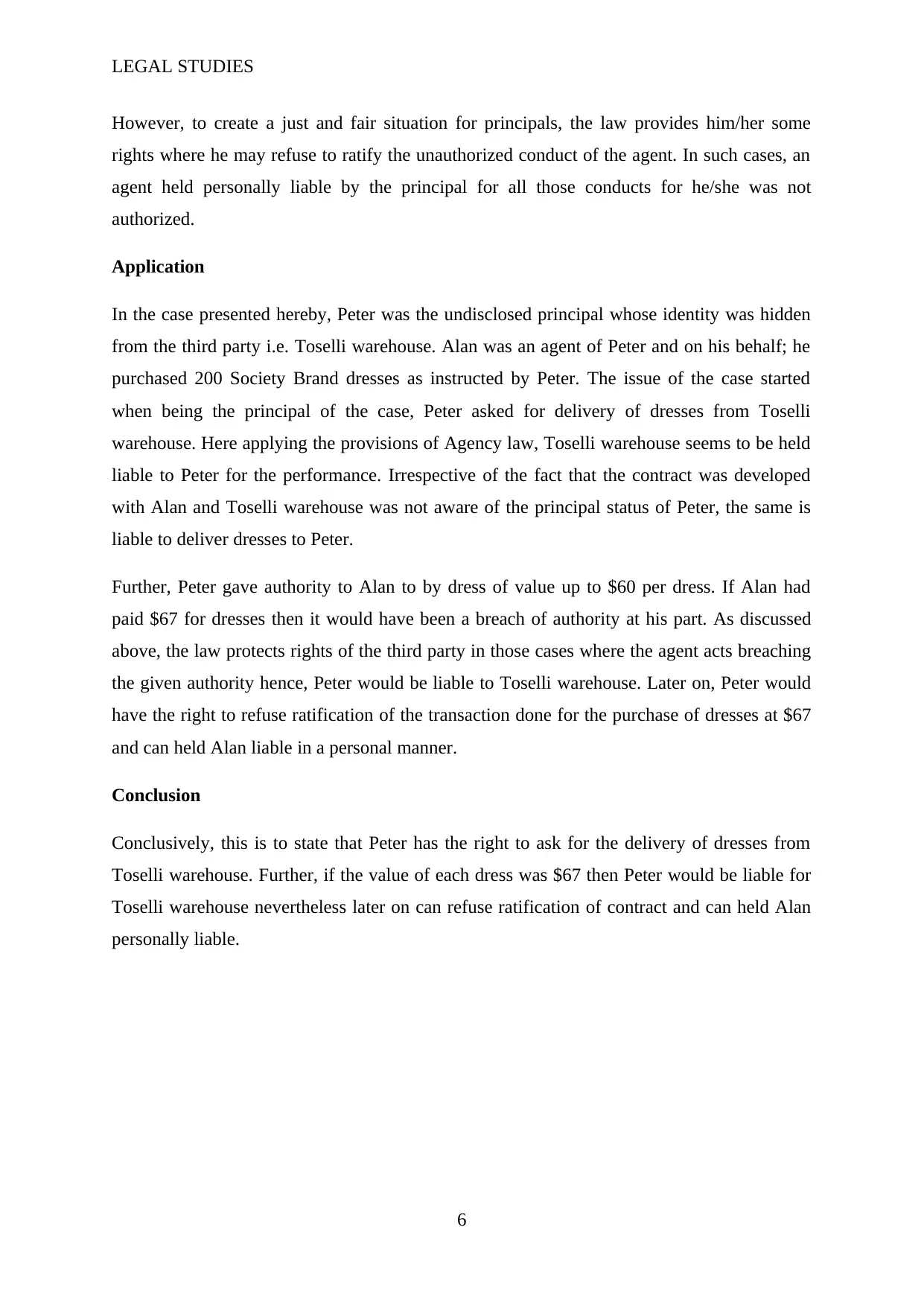
LEGAL STUDIES
However, to create a just and fair situation for principals, the law provides him/her some
rights where he may refuse to ratify the unauthorized conduct of the agent. In such cases, an
agent held personally liable by the principal for all those conducts for he/she was not
authorized.
Application
In the case presented hereby, Peter was the undisclosed principal whose identity was hidden
from the third party i.e. Toselli warehouse. Alan was an agent of Peter and on his behalf; he
purchased 200 Society Brand dresses as instructed by Peter. The issue of the case started
when being the principal of the case, Peter asked for delivery of dresses from Toselli
warehouse. Here applying the provisions of Agency law, Toselli warehouse seems to be held
liable to Peter for the performance. Irrespective of the fact that the contract was developed
with Alan and Toselli warehouse was not aware of the principal status of Peter, the same is
liable to deliver dresses to Peter.
Further, Peter gave authority to Alan to by dress of value up to $60 per dress. If Alan had
paid $67 for dresses then it would have been a breach of authority at his part. As discussed
above, the law protects rights of the third party in those cases where the agent acts breaching
the given authority hence, Peter would be liable to Toselli warehouse. Later on, Peter would
have the right to refuse ratification of the transaction done for the purchase of dresses at $67
and can held Alan liable in a personal manner.
Conclusion
Conclusively, this is to state that Peter has the right to ask for the delivery of dresses from
Toselli warehouse. Further, if the value of each dress was $67 then Peter would be liable for
Toselli warehouse nevertheless later on can refuse ratification of contract and can held Alan
personally liable.
6
However, to create a just and fair situation for principals, the law provides him/her some
rights where he may refuse to ratify the unauthorized conduct of the agent. In such cases, an
agent held personally liable by the principal for all those conducts for he/she was not
authorized.
Application
In the case presented hereby, Peter was the undisclosed principal whose identity was hidden
from the third party i.e. Toselli warehouse. Alan was an agent of Peter and on his behalf; he
purchased 200 Society Brand dresses as instructed by Peter. The issue of the case started
when being the principal of the case, Peter asked for delivery of dresses from Toselli
warehouse. Here applying the provisions of Agency law, Toselli warehouse seems to be held
liable to Peter for the performance. Irrespective of the fact that the contract was developed
with Alan and Toselli warehouse was not aware of the principal status of Peter, the same is
liable to deliver dresses to Peter.
Further, Peter gave authority to Alan to by dress of value up to $60 per dress. If Alan had
paid $67 for dresses then it would have been a breach of authority at his part. As discussed
above, the law protects rights of the third party in those cases where the agent acts breaching
the given authority hence, Peter would be liable to Toselli warehouse. Later on, Peter would
have the right to refuse ratification of the transaction done for the purchase of dresses at $67
and can held Alan liable in a personal manner.
Conclusion
Conclusively, this is to state that Peter has the right to ask for the delivery of dresses from
Toselli warehouse. Further, if the value of each dress was $67 then Peter would be liable for
Toselli warehouse nevertheless later on can refuse ratification of contract and can held Alan
personally liable.
6
Paraphrase This Document
Need a fresh take? Get an instant paraphrase of this document with our AI Paraphraser
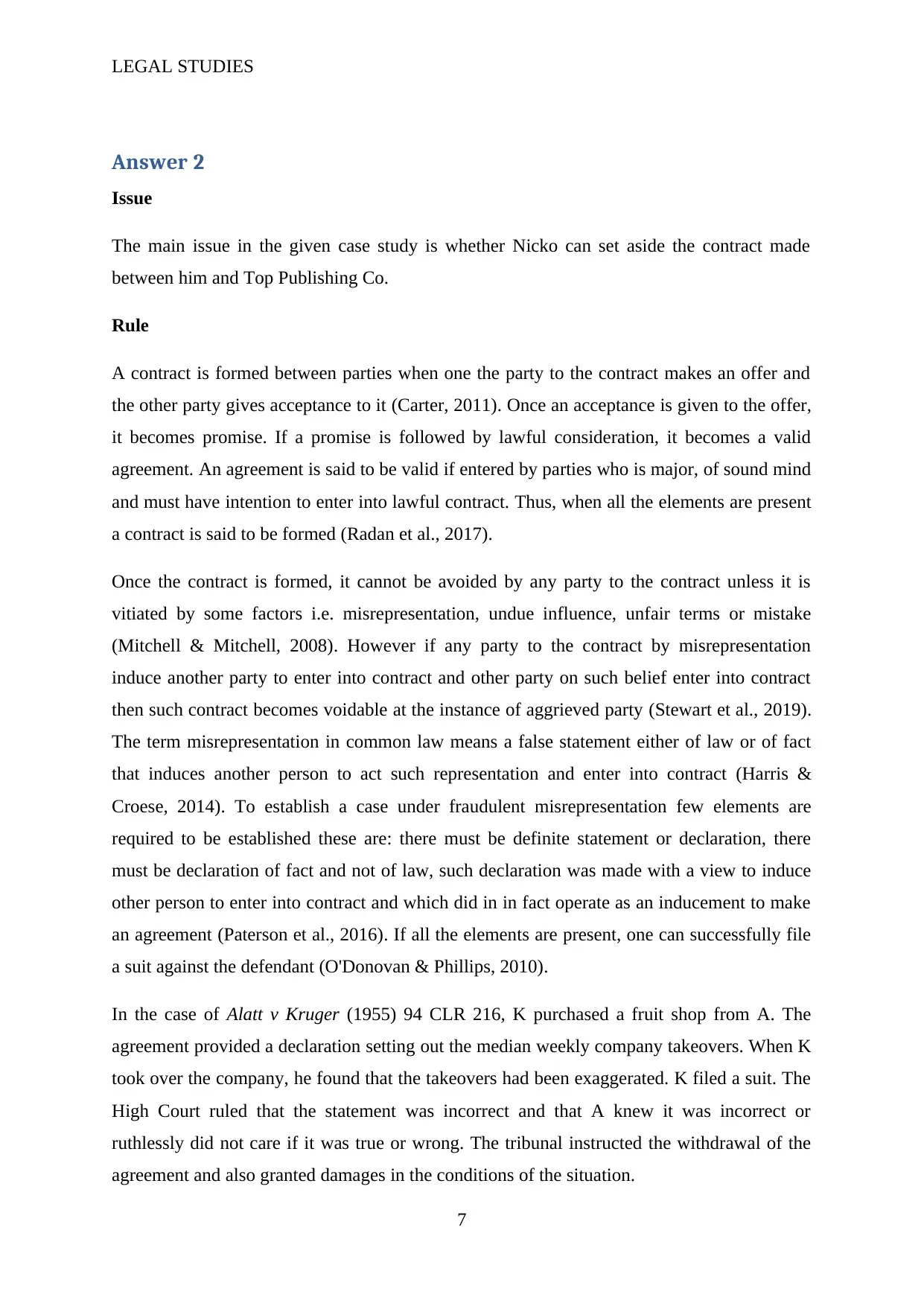
LEGAL STUDIES
Answer 2
Issue
The main issue in the given case study is whether Nicko can set aside the contract made
between him and Top Publishing Co.
Rule
A contract is formed between parties when one the party to the contract makes an offer and
the other party gives acceptance to it (Carter, 2011). Once an acceptance is given to the offer,
it becomes promise. If a promise is followed by lawful consideration, it becomes a valid
agreement. An agreement is said to be valid if entered by parties who is major, of sound mind
and must have intention to enter into lawful contract. Thus, when all the elements are present
a contract is said to be formed (Radan et al., 2017).
Once the contract is formed, it cannot be avoided by any party to the contract unless it is
vitiated by some factors i.e. misrepresentation, undue influence, unfair terms or mistake
(Mitchell & Mitchell, 2008). However if any party to the contract by misrepresentation
induce another party to enter into contract and other party on such belief enter into contract
then such contract becomes voidable at the instance of aggrieved party (Stewart et al., 2019).
The term misrepresentation in common law means a false statement either of law or of fact
that induces another person to act such representation and enter into contract (Harris &
Croese, 2014). To establish a case under fraudulent misrepresentation few elements are
required to be established these are: there must be definite statement or declaration, there
must be declaration of fact and not of law, such declaration was made with a view to induce
other person to enter into contract and which did in in fact operate as an inducement to make
an agreement (Paterson et al., 2016). If all the elements are present, one can successfully file
a suit against the defendant (O'Donovan & Phillips, 2010).
In the case of Alatt v Kruger (1955) 94 CLR 216, K purchased a fruit shop from A. The
agreement provided a declaration setting out the median weekly company takeovers. When K
took over the company, he found that the takeovers had been exaggerated. K filed a suit. The
High Court ruled that the statement was incorrect and that A knew it was incorrect or
ruthlessly did not care if it was true or wrong. The tribunal instructed the withdrawal of the
agreement and also granted damages in the conditions of the situation.
7
Answer 2
Issue
The main issue in the given case study is whether Nicko can set aside the contract made
between him and Top Publishing Co.
Rule
A contract is formed between parties when one the party to the contract makes an offer and
the other party gives acceptance to it (Carter, 2011). Once an acceptance is given to the offer,
it becomes promise. If a promise is followed by lawful consideration, it becomes a valid
agreement. An agreement is said to be valid if entered by parties who is major, of sound mind
and must have intention to enter into lawful contract. Thus, when all the elements are present
a contract is said to be formed (Radan et al., 2017).
Once the contract is formed, it cannot be avoided by any party to the contract unless it is
vitiated by some factors i.e. misrepresentation, undue influence, unfair terms or mistake
(Mitchell & Mitchell, 2008). However if any party to the contract by misrepresentation
induce another party to enter into contract and other party on such belief enter into contract
then such contract becomes voidable at the instance of aggrieved party (Stewart et al., 2019).
The term misrepresentation in common law means a false statement either of law or of fact
that induces another person to act such representation and enter into contract (Harris &
Croese, 2014). To establish a case under fraudulent misrepresentation few elements are
required to be established these are: there must be definite statement or declaration, there
must be declaration of fact and not of law, such declaration was made with a view to induce
other person to enter into contract and which did in in fact operate as an inducement to make
an agreement (Paterson et al., 2016). If all the elements are present, one can successfully file
a suit against the defendant (O'Donovan & Phillips, 2010).
In the case of Alatt v Kruger (1955) 94 CLR 216, K purchased a fruit shop from A. The
agreement provided a declaration setting out the median weekly company takeovers. When K
took over the company, he found that the takeovers had been exaggerated. K filed a suit. The
High Court ruled that the statement was incorrect and that A knew it was incorrect or
ruthlessly did not care if it was true or wrong. The tribunal instructed the withdrawal of the
agreement and also granted damages in the conditions of the situation.
7
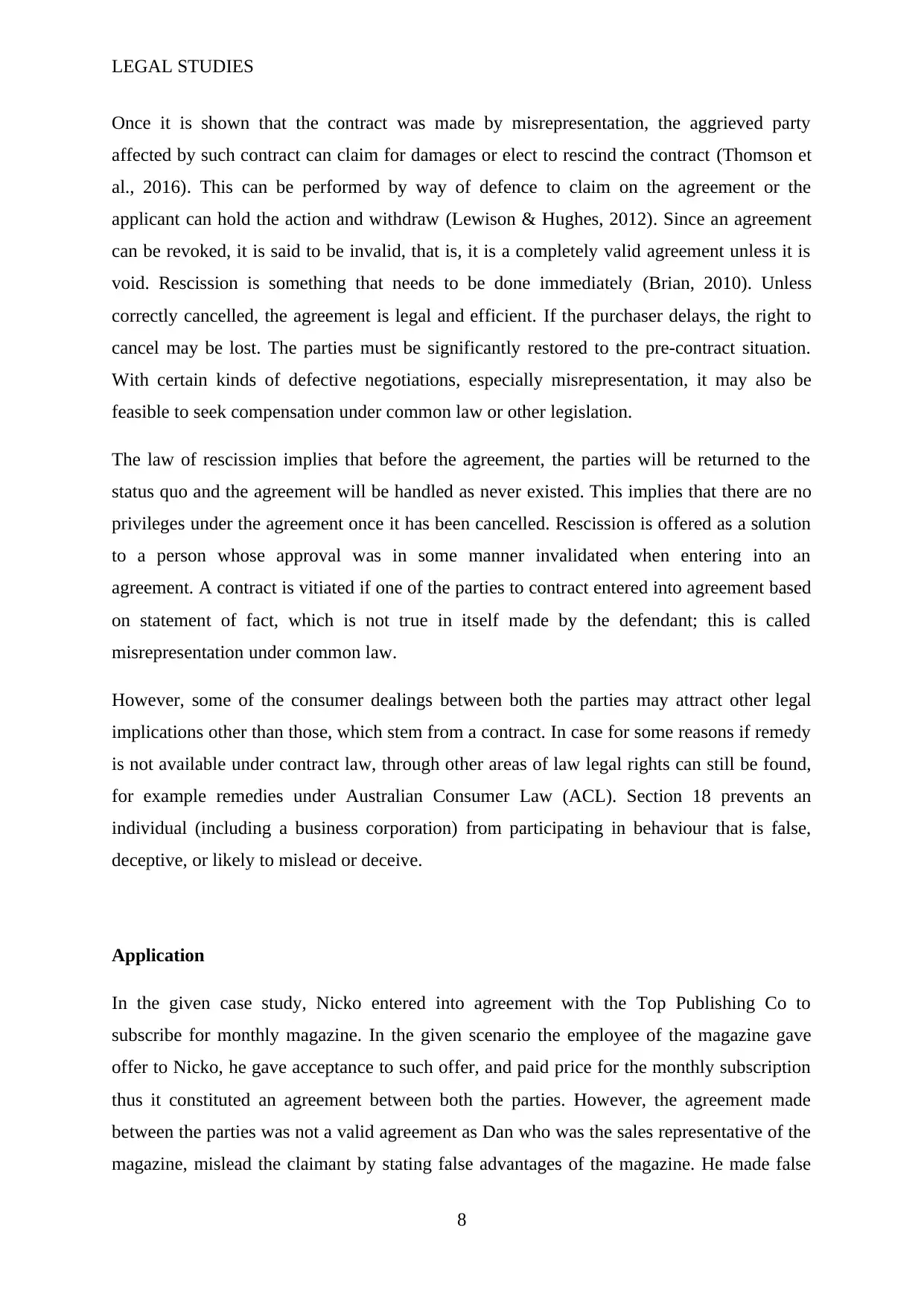
LEGAL STUDIES
Once it is shown that the contract was made by misrepresentation, the aggrieved party
affected by such contract can claim for damages or elect to rescind the contract (Thomson et
al., 2016). This can be performed by way of defence to claim on the agreement or the
applicant can hold the action and withdraw (Lewison & Hughes, 2012). Since an agreement
can be revoked, it is said to be invalid, that is, it is a completely valid agreement unless it is
void. Rescission is something that needs to be done immediately (Brian, 2010). Unless
correctly cancelled, the agreement is legal and efficient. If the purchaser delays, the right to
cancel may be lost. The parties must be significantly restored to the pre-contract situation.
With certain kinds of defective negotiations, especially misrepresentation, it may also be
feasible to seek compensation under common law or other legislation.
The law of rescission implies that before the agreement, the parties will be returned to the
status quo and the agreement will be handled as never existed. This implies that there are no
privileges under the agreement once it has been cancelled. Rescission is offered as a solution
to a person whose approval was in some manner invalidated when entering into an
agreement. A contract is vitiated if one of the parties to contract entered into agreement based
on statement of fact, which is not true in itself made by the defendant; this is called
misrepresentation under common law.
However, some of the consumer dealings between both the parties may attract other legal
implications other than those, which stem from a contract. In case for some reasons if remedy
is not available under contract law, through other areas of law legal rights can still be found,
for example remedies under Australian Consumer Law (ACL). Section 18 prevents an
individual (including a business corporation) from participating in behaviour that is false,
deceptive, or likely to mislead or deceive.
Application
In the given case study, Nicko entered into agreement with the Top Publishing Co to
subscribe for monthly magazine. In the given scenario the employee of the magazine gave
offer to Nicko, he gave acceptance to such offer, and paid price for the monthly subscription
thus it constituted an agreement between both the parties. However, the agreement made
between the parties was not a valid agreement as Dan who was the sales representative of the
magazine, mislead the claimant by stating false advantages of the magazine. He made false
8
Once it is shown that the contract was made by misrepresentation, the aggrieved party
affected by such contract can claim for damages or elect to rescind the contract (Thomson et
al., 2016). This can be performed by way of defence to claim on the agreement or the
applicant can hold the action and withdraw (Lewison & Hughes, 2012). Since an agreement
can be revoked, it is said to be invalid, that is, it is a completely valid agreement unless it is
void. Rescission is something that needs to be done immediately (Brian, 2010). Unless
correctly cancelled, the agreement is legal and efficient. If the purchaser delays, the right to
cancel may be lost. The parties must be significantly restored to the pre-contract situation.
With certain kinds of defective negotiations, especially misrepresentation, it may also be
feasible to seek compensation under common law or other legislation.
The law of rescission implies that before the agreement, the parties will be returned to the
status quo and the agreement will be handled as never existed. This implies that there are no
privileges under the agreement once it has been cancelled. Rescission is offered as a solution
to a person whose approval was in some manner invalidated when entering into an
agreement. A contract is vitiated if one of the parties to contract entered into agreement based
on statement of fact, which is not true in itself made by the defendant; this is called
misrepresentation under common law.
However, some of the consumer dealings between both the parties may attract other legal
implications other than those, which stem from a contract. In case for some reasons if remedy
is not available under contract law, through other areas of law legal rights can still be found,
for example remedies under Australian Consumer Law (ACL). Section 18 prevents an
individual (including a business corporation) from participating in behaviour that is false,
deceptive, or likely to mislead or deceive.
Application
In the given case study, Nicko entered into agreement with the Top Publishing Co to
subscribe for monthly magazine. In the given scenario the employee of the magazine gave
offer to Nicko, he gave acceptance to such offer, and paid price for the monthly subscription
thus it constituted an agreement between both the parties. However, the agreement made
between the parties was not a valid agreement as Dan who was the sales representative of the
magazine, mislead the claimant by stating false advantages of the magazine. He made false
8
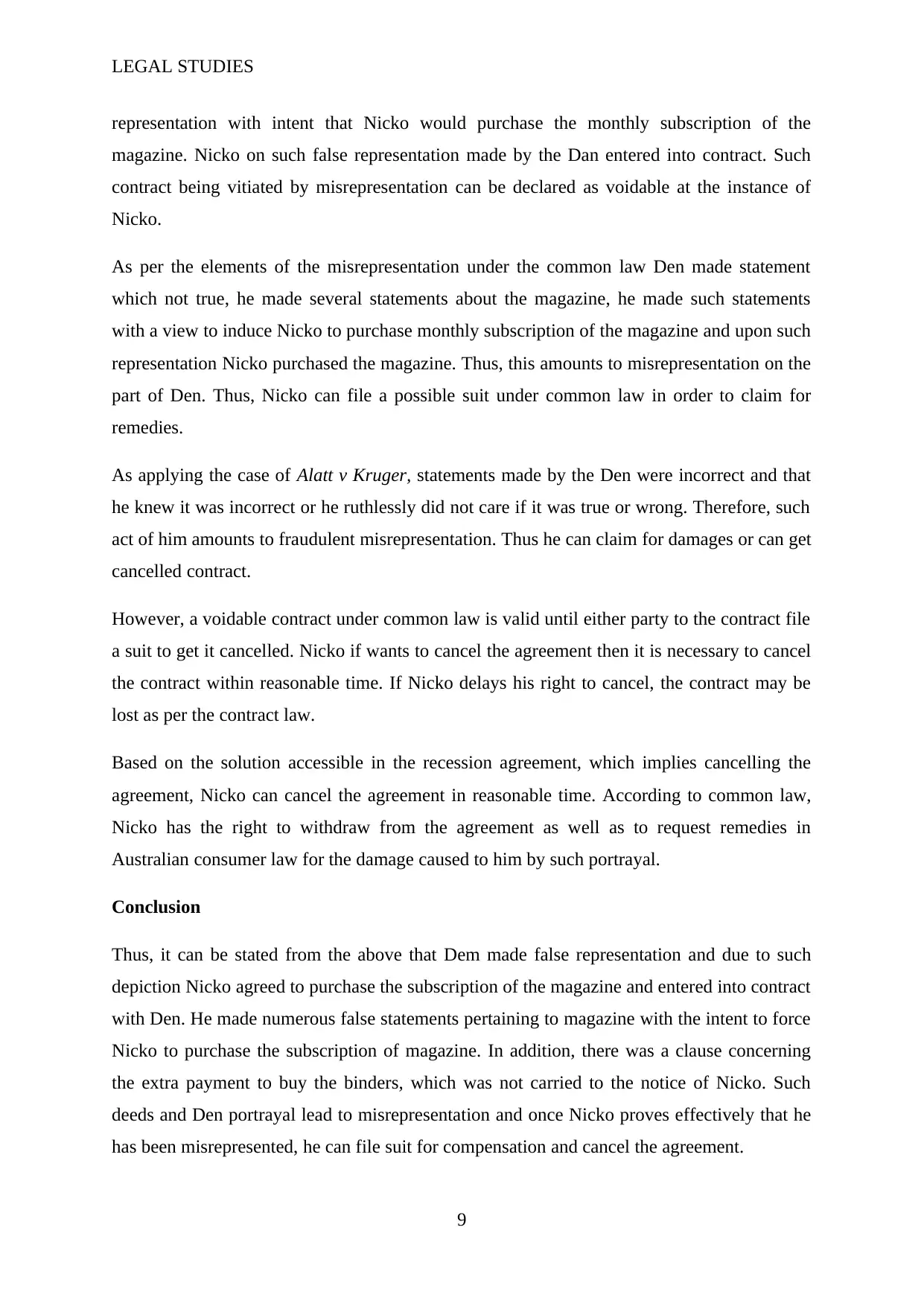
LEGAL STUDIES
representation with intent that Nicko would purchase the monthly subscription of the
magazine. Nicko on such false representation made by the Dan entered into contract. Such
contract being vitiated by misrepresentation can be declared as voidable at the instance of
Nicko.
As per the elements of the misrepresentation under the common law Den made statement
which not true, he made several statements about the magazine, he made such statements
with a view to induce Nicko to purchase monthly subscription of the magazine and upon such
representation Nicko purchased the magazine. Thus, this amounts to misrepresentation on the
part of Den. Thus, Nicko can file a possible suit under common law in order to claim for
remedies.
As applying the case of Alatt v Kruger, statements made by the Den were incorrect and that
he knew it was incorrect or he ruthlessly did not care if it was true or wrong. Therefore, such
act of him amounts to fraudulent misrepresentation. Thus he can claim for damages or can get
cancelled contract.
However, a voidable contract under common law is valid until either party to the contract file
a suit to get it cancelled. Nicko if wants to cancel the agreement then it is necessary to cancel
the contract within reasonable time. If Nicko delays his right to cancel, the contract may be
lost as per the contract law.
Based on the solution accessible in the recession agreement, which implies cancelling the
agreement, Nicko can cancel the agreement in reasonable time. According to common law,
Nicko has the right to withdraw from the agreement as well as to request remedies in
Australian consumer law for the damage caused to him by such portrayal.
Conclusion
Thus, it can be stated from the above that Dem made false representation and due to such
depiction Nicko agreed to purchase the subscription of the magazine and entered into contract
with Den. He made numerous false statements pertaining to magazine with the intent to force
Nicko to purchase the subscription of magazine. In addition, there was a clause concerning
the extra payment to buy the binders, which was not carried to the notice of Nicko. Such
deeds and Den portrayal lead to misrepresentation and once Nicko proves effectively that he
has been misrepresented, he can file suit for compensation and cancel the agreement.
9
representation with intent that Nicko would purchase the monthly subscription of the
magazine. Nicko on such false representation made by the Dan entered into contract. Such
contract being vitiated by misrepresentation can be declared as voidable at the instance of
Nicko.
As per the elements of the misrepresentation under the common law Den made statement
which not true, he made several statements about the magazine, he made such statements
with a view to induce Nicko to purchase monthly subscription of the magazine and upon such
representation Nicko purchased the magazine. Thus, this amounts to misrepresentation on the
part of Den. Thus, Nicko can file a possible suit under common law in order to claim for
remedies.
As applying the case of Alatt v Kruger, statements made by the Den were incorrect and that
he knew it was incorrect or he ruthlessly did not care if it was true or wrong. Therefore, such
act of him amounts to fraudulent misrepresentation. Thus he can claim for damages or can get
cancelled contract.
However, a voidable contract under common law is valid until either party to the contract file
a suit to get it cancelled. Nicko if wants to cancel the agreement then it is necessary to cancel
the contract within reasonable time. If Nicko delays his right to cancel, the contract may be
lost as per the contract law.
Based on the solution accessible in the recession agreement, which implies cancelling the
agreement, Nicko can cancel the agreement in reasonable time. According to common law,
Nicko has the right to withdraw from the agreement as well as to request remedies in
Australian consumer law for the damage caused to him by such portrayal.
Conclusion
Thus, it can be stated from the above that Dem made false representation and due to such
depiction Nicko agreed to purchase the subscription of the magazine and entered into contract
with Den. He made numerous false statements pertaining to magazine with the intent to force
Nicko to purchase the subscription of magazine. In addition, there was a clause concerning
the extra payment to buy the binders, which was not carried to the notice of Nicko. Such
deeds and Den portrayal lead to misrepresentation and once Nicko proves effectively that he
has been misrepresented, he can file suit for compensation and cancel the agreement.
9
Secure Best Marks with AI Grader
Need help grading? Try our AI Grader for instant feedback on your assignments.
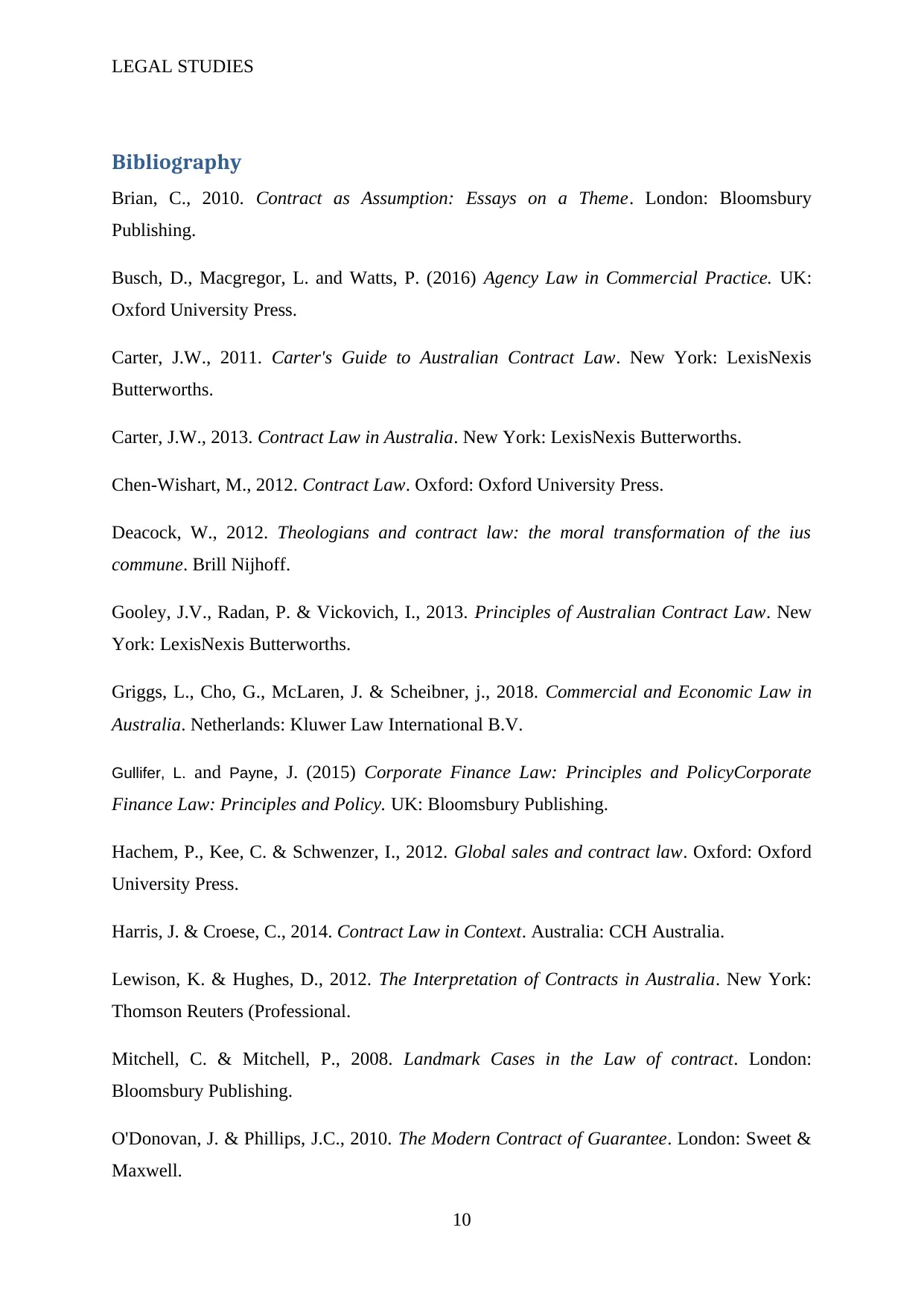
LEGAL STUDIES
Bibliography
Brian, C., 2010. Contract as Assumption: Essays on a Theme. London: Bloomsbury
Publishing.
Busch, D., Macgregor, L. and Watts, P. (2016) Agency Law in Commercial Practice. UK:
Oxford University Press.
Carter, J.W., 2011. Carter's Guide to Australian Contract Law. New York: LexisNexis
Butterworths.
Carter, J.W., 2013. Contract Law in Australia. New York: LexisNexis Butterworths.
Chen-Wishart, M., 2012. Contract Law. Oxford: Oxford University Press.
Deacock, W., 2012. Theologians and contract law: the moral transformation of the ius
commune. Brill Nijhoff.
Gooley, J.V., Radan, P. & Vickovich, I., 2013. Principles of Australian Contract Law. New
York: LexisNexis Butterworths.
Griggs, L., Cho, G., McLaren, J. & Scheibner, j., 2018. Commercial and Economic Law in
Australia. Netherlands: Kluwer Law International B.V.
Gullifer, L. and Payne, J. (2015) Corporate Finance Law: Principles and PolicyCorporate
Finance Law: Principles and Policy. UK: Bloomsbury Publishing.
Hachem, P., Kee, C. & Schwenzer, I., 2012. Global sales and contract law. Oxford: Oxford
University Press.
Harris, J. & Croese, C., 2014. Contract Law in Context. Australia: CCH Australia.
Lewison, K. & Hughes, D., 2012. The Interpretation of Contracts in Australia. New York:
Thomson Reuters (Professional.
Mitchell, C. & Mitchell, P., 2008. Landmark Cases in the Law of contract. London:
Bloomsbury Publishing.
O'Donovan, J. & Phillips, J.C., 2010. The Modern Contract of Guarantee. London: Sweet &
Maxwell.
10
Bibliography
Brian, C., 2010. Contract as Assumption: Essays on a Theme. London: Bloomsbury
Publishing.
Busch, D., Macgregor, L. and Watts, P. (2016) Agency Law in Commercial Practice. UK:
Oxford University Press.
Carter, J.W., 2011. Carter's Guide to Australian Contract Law. New York: LexisNexis
Butterworths.
Carter, J.W., 2013. Contract Law in Australia. New York: LexisNexis Butterworths.
Chen-Wishart, M., 2012. Contract Law. Oxford: Oxford University Press.
Deacock, W., 2012. Theologians and contract law: the moral transformation of the ius
commune. Brill Nijhoff.
Gooley, J.V., Radan, P. & Vickovich, I., 2013. Principles of Australian Contract Law. New
York: LexisNexis Butterworths.
Griggs, L., Cho, G., McLaren, J. & Scheibner, j., 2018. Commercial and Economic Law in
Australia. Netherlands: Kluwer Law International B.V.
Gullifer, L. and Payne, J. (2015) Corporate Finance Law: Principles and PolicyCorporate
Finance Law: Principles and Policy. UK: Bloomsbury Publishing.
Hachem, P., Kee, C. & Schwenzer, I., 2012. Global sales and contract law. Oxford: Oxford
University Press.
Harris, J. & Croese, C., 2014. Contract Law in Context. Australia: CCH Australia.
Lewison, K. & Hughes, D., 2012. The Interpretation of Contracts in Australia. New York:
Thomson Reuters (Professional.
Mitchell, C. & Mitchell, P., 2008. Landmark Cases in the Law of contract. London:
Bloomsbury Publishing.
O'Donovan, J. & Phillips, J.C., 2010. The Modern Contract of Guarantee. London: Sweet &
Maxwell.
10
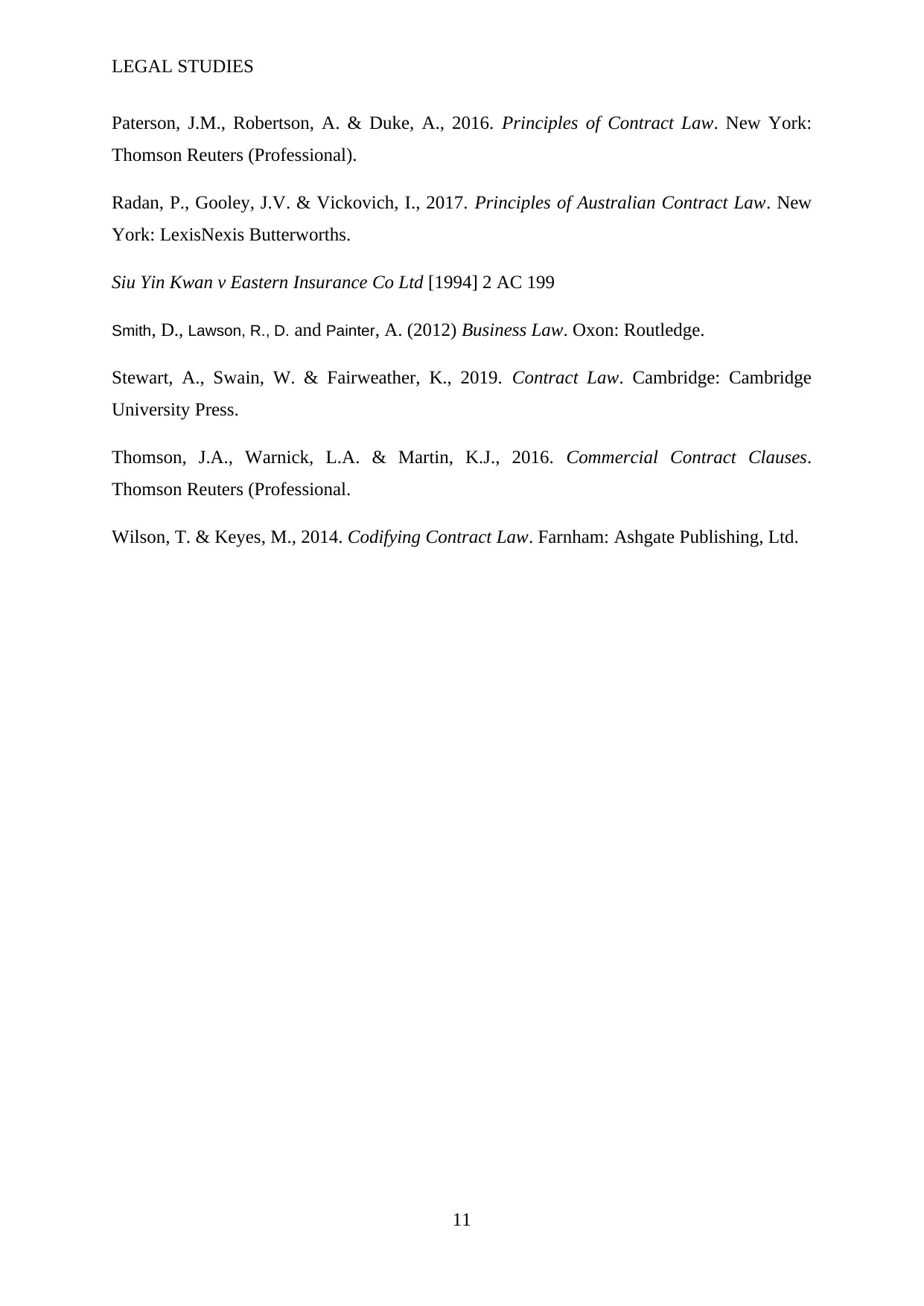
LEGAL STUDIES
Paterson, J.M., Robertson, A. & Duke, A., 2016. Principles of Contract Law. New York:
Thomson Reuters (Professional).
Radan, P., Gooley, J.V. & Vickovich, I., 2017. Principles of Australian Contract Law. New
York: LexisNexis Butterworths.
Siu Yin Kwan v Eastern Insurance Co Ltd [1994] 2 AC 199
Smith, D., Lawson, R., D. and Painter, A. (2012) Business Law. Oxon: Routledge.
Stewart, A., Swain, W. & Fairweather, K., 2019. Contract Law. Cambridge: Cambridge
University Press.
Thomson, J.A., Warnick, L.A. & Martin, K.J., 2016. Commercial Contract Clauses.
Thomson Reuters (Professional.
Wilson, T. & Keyes, M., 2014. Codifying Contract Law. Farnham: Ashgate Publishing, Ltd.
11
Paterson, J.M., Robertson, A. & Duke, A., 2016. Principles of Contract Law. New York:
Thomson Reuters (Professional).
Radan, P., Gooley, J.V. & Vickovich, I., 2017. Principles of Australian Contract Law. New
York: LexisNexis Butterworths.
Siu Yin Kwan v Eastern Insurance Co Ltd [1994] 2 AC 199
Smith, D., Lawson, R., D. and Painter, A. (2012) Business Law. Oxon: Routledge.
Stewart, A., Swain, W. & Fairweather, K., 2019. Contract Law. Cambridge: Cambridge
University Press.
Thomson, J.A., Warnick, L.A. & Martin, K.J., 2016. Commercial Contract Clauses.
Thomson Reuters (Professional.
Wilson, T. & Keyes, M., 2014. Codifying Contract Law. Farnham: Ashgate Publishing, Ltd.
11
1 out of 12
Related Documents
Your All-in-One AI-Powered Toolkit for Academic Success.
+13062052269
info@desklib.com
Available 24*7 on WhatsApp / Email
![[object Object]](/_next/static/media/star-bottom.7253800d.svg)
Unlock your academic potential
© 2024 | Zucol Services PVT LTD | All rights reserved.





